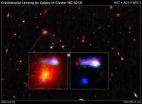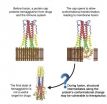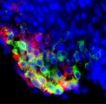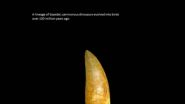(Press-News.org) HOUSTON -- (July 31, 2014) -- Scientists have new clues this week about one of the baffling electronic properties of the iron-based high-temperature superconductor barium iron nickel arsenide. A Rice University-led team of U.S., German and Chinese physicists has published the first evidence, based on sophisticated neutron measurements, of a link between magnetic properties and the material's tendency, at sufficiently low temperatures, to become a better conductor of electricity in some directions than in others.
The odd behavior, which has been documented in a number of materials, occurs at temperatures slightly higher than those needed to bring about magnetism; magnetism is believed to be essential for the origin of high-temperature superconductivity. In a new study appearing online this week in the journal Science Express, scientists at Rice, the Chinese Academy of Sciences in Beijing and Germany's Technische Universität München (TUM) offer the first evidence that the directionally dependent behavior arises from inherent physical properties of the material rather than from extraneous impurities, as had been previously suggested.
The new findings are based on sophisticated inelastic neutron-scattering experiments performed on several samples of barium iron nickel arsenide at the PUMA triple axis spectrometer at TUM's Heinz Maier-Leibnitz Zentrum in Garching, Germany. The research team said they hope the findings will prove useful in explaining the underlying physics of directionally dependent electronic phenomena that have been observed in several different types of superconducting materials.
"Most high-temperature superconductors, and many closely related compounds, exhibit a number of exotic electronic phases, particularly as they approach the critical temperature where superconductivity arises," said Pengcheng Dai, professor of physics and astronomy at Rice and the study's senior corresponding author. "Inelastic neutron scattering and other techniques are now allowing us to explore the physical basis of many of these phases."
Explaining high-temperature superconductivity remains the foremost challenge in condensed matter physics. First documented in 1986, the phenomenon is marked by zero electrical resistance in some crystalline ceramic materials below a critical temperature. While very cold, the critical temperatures for high-temperature superconductors -- between 50 and 150 kelvins above absolute zero -- are relatively high in comparison with the temperatures required for conventional superconductivity.
Like most high-temperature superconductors, barium iron nickel arsenide is a composite crystal. Its molecular structure consists of layers of arsenic and barium atoms that are sandwiched between checkerboard planes of iron atoms. The nickel atoms are then partially substituted for iron to tune the material's physical properties. The atoms in the crystals form an ordered pattern that looks identical in both the right-left (x-axis) and forward-back (y-axis) directions, but not in the up-down (z-axis).
At room temperature, the material acts as one might expect, conducting electricity equally well along both its x-axis and y-axis. However, as the material is cooled to near the critical temperature for magnetism, it passes through a phase where electrical resistance is higher in one direction than the other. Physicists call directionally dependent behavior "anisotropic resistance."
In the new study, Dai and colleagues bombarded crystals of barium iron nickel arsenide with neutrons. Neutron-scattering measurements can reveal the molecular structure of materials in great detail, and inelastic neutron-scattering tests allow physicists to see, among others, the vibrational properties of materials. In the magnetic inelastic scattering experiment at TUM, the incoming neutrons brought about short-lived magnetic waves in the crystals. Surprisingly, the intensity of these magnetic waves turned out to be different in the x and y directions. The experiments revealed that this directional dependence of magnetic excitations in the barium iron nickel arsenide occurs at precisely the same temperature range as the anisotropic resistance, thus establishing a crucial link between the two phenomena.
Rice theoretical physicist and study co-author Andriy Nevidomskyy, assistant professor of physics and astronomy, used the analogy of a crowd gathered at a stadium to watch a sporting event.
"During the game, all eyes are on the field, and this is an ordered state that describes all the individuals in the crowd in relation to one another," he said. "This state corresponds to the collective arrangement of electrons we see in magnetism and in superconductivity. The disordered arrangement we observe at room temperature, on the other hand, corresponds to the chaos we would see in the crowd one hour before the game begins, when people are turning from side to side and occasionally glancing at the field.
"The anisotropic state found in our study corresponds to a moment just before the kickoff, when the individuals are still looking in random directions but are aware that the game is about to start," Nevidomskyy said. "The incoming neutron pulse is the equivalent of someone blowing a whistle on the field. For a split second, the crowd reacts as one to the whistle, and every head turns to see if the game has begun. The individuals in the crowd quickly return to their random behavior, but the whistle has revealed an order that wasn't present an hour before."
The inelastic neutron scattering experiments uncovered an analogous behavior in the barium iron nickel arsenide. At high temperatures, the pulse of energy revealed no underlying order. The temporary, collective anisotropic order occurred only in the brief temperature interval prior to the onset of magnetism where the anisotropic resistance had previously been measured.
Rice theoretical physicist Qimiao Si, another study co-author, said the magnetic behavior observed by the inelastic neutron-scattering measurements reflects the way the spins of the electrons are dynamically organized in the material.
"This spin excitation anisotropy sheds new light on the microscopic origins of electronic phases in the iron pnictide superconductors," said Si, Rice's Harry C. and Olga K. Wiess Professor of Physics and Astronomy. "It may help explain the interplay between magnetism and superconductivity and, more generally, the mechanism for superconductivity, in the iron pnictide superconductors."
INFORMATION:
Study co-authors include Xingye Lu, Rui Zhang and Huiqian Luo, all of the Chinese Academy of Sciences, and J.T. Park of TUM's Heinz Maier-Leibnitz Zentrum. The research was funded by China's Ministry of Science and Technology, the National Natural Science Foundation of China, the Robert A. Welch Foundation, the National Science Foundation and the Alexander von Humboldt Foundation.
A high-resolution infographic is available for download at:
http://news.rice.edu/wp-content/uploads/2014/07/AnistropyInHighTemp.pdf
Credit: Tanyia Johnson/Rice University
A copy of the Science Express paper is available at:
http://www.sciencemag.org/content/early/recent
Located on a 300-acre forested campus in Houston, Rice University is consistently ranked among the nation's top 20 universities by U.S. News & World Report. Rice has highly respected schools of Architecture, Business, Continuing Studies, Engineering, Humanities, Music, Natural Sciences and Social Sciences and is home to the Baker Institute for Public Policy. With 3,920 undergraduates and 2,567 graduate students, Rice's undergraduate student-to-faculty ratio is just over 6-to-1. Its residential college system builds close-knit communities and lifelong friendships, just one reason why Rice has been ranked No. 1 for best quality of life multiple times by the Princeton Review and No. 2 for "best value" among private universities by Kiplinger's Personal Finance.
Study finds physical link to strange electronic behavior
Neutron measurements offer new clues about iron-based superconductor
2014-07-31
ELSE PRESS RELEASES FROM THIS DATE:
Hubble shows farthest lensing galaxy yields clues to early universe
2014-07-31
Astronomers using NASA's Hubble Space Telescope have unexpectedly discovered the most distant galaxy that acts as a cosmic magnifying glass. Seen here as it looked 9.6 billion years ago, this monster elliptical galaxy breaks the previous record-holder by 200 million years.
These "lensing" galaxies are so massive that their gravity bends, magnifies, and distorts light from objects behind it, a phenomenon called gravitational lensing. Finding one in such a small area of the sky is so rare that you would normally have to survey a region hundreds of times larger to find just ...
Researchers uncover clues to flu's mechanisms
2014-07-31
HOUSTON – (July 31, 2014) – A flu virus acts like a Trojan horse as it attacks and infects host cells. Scientists at Rice University and Baylor College of Medicine have acquired a clearer view of the well-hidden mechanism involved.
Their computer simulations may lead to new strategies to stop influenza, perhaps even a one-size-fits-all vaccine.
The discovery detailed this week in the Proceedings of the National Academy of Science shows the path taken by hemagglutinin, a glycoprotein that rides the surface of the influenza virus, as it releases fusion peptides to invade ...
UF study advances 'DNA revolution,' tells butterflies' evolutionary history
2014-07-31
GAINESVILLE, Fla. --- By tracing nearly 3,000 genes to the earliest common ancestor of butterflies and moths, University of Florida scientists have created an extensive "Tree of Lepidoptera" in the first study to use large-scale, next-generation DNA sequencing.
Among the study's more surprising findings: Butterflies are more closely related to small moths than to large ones, which completely changes scientists' understanding of how butterflies evolved. The study also found that some insects once classified as moths are actually butterflies, increasing the number of butterfly ...
NYU CDUHR researchers look at prescription opioid abuse among young adults in NYC
2014-07-31
The prevalence of heroin use has been rising steadily in the U.S in recent years. According to the National Survey on Drug Use and Health, the number of individuals reporting past year heroin use almost doubled between 2007 (373,000) and 2012 (669,000). Emerging evidence suggests the increase may be linked to prescription opioid (PO) users who transition from oral and/or intranasal PO use to heroin use, with POs providing the entryway to regular opioid use, and ultimately, heroin injection. This drug-use trajectory appears to have become increasingly common over the past ...
NYU research looks to combat US Latina immigrant obesity
2014-07-31
According to the U.S. Census Bureau, Latinos are the largest minority group in the United States, comprising 16.7% of the population. Approximately one-third of Latinos are obese and are 1.2 times as likely to be obese compared to non-Hispanic Whites.
NYU College of Nursing student researcher Lauren Gerchow, BSN, RN, MSN candidate, has sought to identify the factors that contribute to this problem by compiling a systematic review of qualitative studies that focused on food patterns in Latina women recently published in Nursing Research.
"The review focuses on women ...
Stanford professor finds that wildfires and other burns play bigger role in climate change
2014-07-31
It has long been known that biomass burning – burning forests to create agricultural lands, burning savannah as a ritual , slash-and-burn agriculture and wildfires – figures into both climate change and public health.
But until the release of a new study by Stanford University Civil and Environmental Engineering Professor Mark Z. Jacobson, the degree of that contribution had never been comprehensively quantified.
Jacobson's research, detailed in a paper published July 30 in the Journal of Geophysical Research: Atmospheres, is based on a three-dimensional computer model ...
Childhood coxsackie virus infection depletes cardiac stem cells and might compromise heart health in adults
2014-07-31
There is epidemiological evidence that links type B coxsackie virus (CVB) infection with heart disease, and research published on July 31st in PLOS Pathogens now suggests a mechanism by which early infection impairs the heart's ability to tolerate stress at later stages of life.
CVB infection is very common and affects mostly children. The symptoms range widely: over half of the infections are thought to be asymptomatic, the majority of children who get sick have only a mild fever, and a very small proportion get inflammation of the heart or brain. On the other hand, ...
Multidisciplinary study reveals big story of cultural migration
2014-07-31
Quantifying and transforming the history of culture into visual representation isn't easy. There are thousands of individual stories across millennia to consider, and some historical conditions are nearly impossible to measure.
Addressing this challenge, Dr. Maximilian Schich, associate professor of arts and technology at The University of Texas at Dallas, has brought together a team of network and complexity scientists to create and quantify a big picture of European and North American cultural history.
Schich, an art historian who works under the umbrella of the ...
Shrinking dinosaurs evolved into flying birds
2014-07-31
VIDEO:
This movie is an animated version of how birds arose from a very special lineage of evolving dinosaurs.
Click here for more information.
A new study involving scientists from the University of Southampton has revealed how massive, meat-eating, ground-dwelling dinosaurs evolved into agile flying birds: they just kept shrinking and shrinking, for over 50 million years.
Today, in the journal Science, the researchers present a detailed family tree of dinosaurs and their ...
Innovative 'genotype first' approach uncovers protective factor for heart disease
2014-07-31
Cambridge, MA. Thurs. July 31, 2014 — Extensive sequencing of DNA from thousands of individuals in Finland has unearthed scores of mutations that destroy gene function and are found at unusually high frequencies. Among these are two mutations in a gene called LPA that may reduce a person's risk of heart disease. These findings are an exciting proof-of-concept for a new "genotype first" approach to identifying rare genetic variants associated with, or protecting from, disease followed by extensive medical review of carriers. The new study by researchers from the Broad Institute, ...
LAST 30 PRESS RELEASES:
Scientists discover a new signaling pathway and design a novel drug for liver fibrosis
High-precision blood glucose level prediction achieved by few-molecule reservoir computing
The importance of communicating to the public during a pandemic, and the personal risk it can lead to
Improving health communication to save lives during epidemics
Antimicrobial-resistant hospital infections remain at least 12% above pre-pandemic levels, major US study finds
German study finds antibiotic use in patients hospitalised with COVID-19 appears to have no beneficial effect on clinical outcomes
Targeting specific protein regions offers a new treatment approach in medulloblastoma
$2.7 million grant to explore hypoxia’s impact on blood stem cells
Cardiovascular societies propel plans forward for a new American Board of Cardiovascular Medicine
Hebrew SeniorLife selected for nationwide collaborative to accelerate system-wide spread of age-friendly care for older adults
New tool helps identify babies at high-risk for RSV
Reno/Sparks selected to be part of Urban Heat Mapping Campaign
Advance in the treatment of acute heart failure identified
AGS honors Dr. Rainier P. Soriano with Dennis W. Jahnigen Memorial Award at #AGS24 for proven excellence in geriatrics education
New offshore wind turbines can take away energy from existing ones
Unprecedented research probes the relationship between sleep and memory in napping babies and young children
Job losses help explain increase in drug deaths among Black Americans
Nationwide, 32 local schools win NFL PLAY 60 grants for physical activity
Exposure to noise – even while in the egg – impairs bird development and fitness
Vitamin D availability enhances antitumor microbes in mice
Conservation actions have improved the state of biodiversity worldwide
Corporate emission targets are incompatible with global climate goals
Vitamin D alters mouse gut bacteria to give better cancer immunity
Escape the vapes: scientists call for global shift to curb consumer use of disposable technologies
First-of-its-kind study definitively shows that conservation actions are effective at halting and reversing biodiversity loss
A shortcut for drug discovery
Food in sight? The liver is ready!
Climate change could become the main driver of biodiversity decline by mid-century
Voluntary corporate emissions targets not enough to create real climate action
Curiosity promotes biodiversity
[Press-News.org] Study finds physical link to strange electronic behaviorNeutron measurements offer new clues about iron-based superconductor






